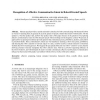Free Online Productivity Tools
i2Speak
i2Symbol
i2OCR
iTex2Img
iWeb2Print
iWeb2Shot
i2Type
iPdf2Split
iPdf2Merge
i2Bopomofo
i2Arabic
i2Style
i2Image
i2PDF
iLatex2Rtf
Sci2ools
AROBOTS
2002
2002
Recognition of Affective Communicative Intent in Robot-Directed Speech
Human speech provides a natural and intuitive interface for both communicating with humanoid robots as well as for teaching them. In general, the acoustic pattern of speech contains three kinds of information: who the speaker is, what the speaker said, and how the speaker said it. This paper focuses on the question of recognizing affective communicative intent in robot-directed speech without looking into the linguistic content. We present an approach for recognizing four distinct prosodic patterns that communicate praise, prohibition, attention, and comfort to preverbal infants. These communicative intents are well matched to teaching a robot since praise, prohibition, and directing the robot's attention to relevant aspects of a task, could be used by a human instructor to intuitively facilitate the robot's learning process. We integrate this perceptual ability into our robot's "emotion" system, thereby allowing a human to directly manipulate the robot's ...
| Added | 16 Dec 2010 |
| Updated | 16 Dec 2010 |
| Type | Journal |
| Year | 2002 |
| Where | AROBOTS |
| Authors | Cynthia Breazeal, Lijin Aryananda |
Comments (0)

